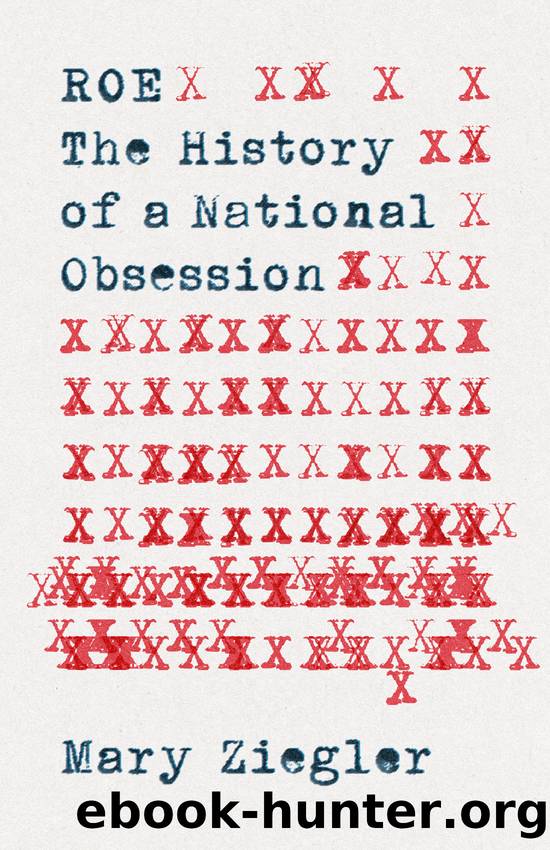Roe by Mary Ziegler

Author:Mary Ziegler
Language: eng
Format: epub
ISBN: 9780300266108
Publisher: Yale University Press
7
Religious Liberty and Equal Treatment
Janet Folger Porter saw herself at the forefront of two wars, one waged against innocent children, the other against Christianity. Porter grew up in a Cleveland suburb, the only daughter in a family of four, and she learned at an early age how to hold her own in an argument. At age nine, when her family attended one of Billy Grahamâs crusades, Janet stepped forward to declare that God was real. She believed that everyone was a sinner, and the wages of sin were death. When it came to who would pay the price, she explained, there were two options: (A) Janet Folger Porter; or (B) Jesus. She chose option B.1
She did not think much about abortion until high school, when her teacher brought in guest speakers to present opposing views on the issue. The pro-life speaker showed a slide of babies in garbage bags, and Porter recoiled, but she did not find an outlet for pro-life work until she went to college and co-founded a chapter of Students for Life at Cleveland State University. She had a flair for the dramatic: to depict the lives lost to abortion, she created a display that reached three stories high, supported by helium balloons. Some of her college classmates did not approve of her, but Porter did not mind being hated. Enraging the right people meant she was doing something right.2
Porter quickly became a rising star in Ohio Right to Life. She worked under Mark Lally, a meticulous lawyer who had taught for a time at the St. Thomas Aquinas School in nearby Zanesville. In the late 1980s, while attending a major right-to-life legislative conference with Lally, Folger proposed an idea: laws banning abortion when doctors could detect brain waves or a fetal heartbeat.3 The judges and lawmakers she addressed dismissed her idea, but they did not know how she reacted to being patronized.4
As the chief lobbyist for Ohio State Right to Life, she was instrumental in the passage of the nationâs first ban on partial-birth abortion, in 1995. Two years later, she moved to South Florida to work for D. James Kennedy, a prominent televangelist and former tango instructor known for his intellectual approach to ministry. She took charge of Kennedyâs fledgling Center for Reclaiming America, where she argued that the nation had declared war on Christians, especially when it came to gay rights and legal abortion. The common denominator, she believed, was that leftists claimed to champion freedom of conscience while âforcing people to embrace their behavior.â In 2003, she left the center to found her own group, Faith2Action.5
Right-to-lifers like Porter saw abortion as an act of unjustified killingâone that ignored scientific evidence of the personhood of the fetus. After 2008, abortion foes also believed that religious liberty and abortion had become increasingly intertwined. To begin with, some abortion foes suggested, Roe created a single national standard and did not let those with different religious beliefs follow their own faith traditions, even when they comprised a majority of a stateâs voters.
Download
This site does not store any files on its server. We only index and link to content provided by other sites. Please contact the content providers to delete copyright contents if any and email us, we'll remove relevant links or contents immediately.
On the Front Line with the Women Who Fight Back by Stacey Dooley(4800)
The Rules Do Not Apply by Ariel Levy(4795)
The Lonely City by Olivia Laing(4714)
Bluets by Maggie Nelson(4437)
The Confidence Code by Katty Kay(4166)
Three Women by Lisa Taddeo(3329)
Not a Diet Book by James Smith(3302)
Inferior by Angela Saini(3213)
Confessions of a Video Vixen by Karrine Steffans(3212)
A Woman Makes a Plan by Maye Musk(3178)
Pledged by Alexandra Robbins(3106)
Wild Words from Wild Women by Stephens Autumn(3047)
Nice Girls Don't Get the Corner Office by Lois P. Frankel(2975)
Brave by Rose McGowan(2765)
Women & Power by Mary Beard(2692)
Why I Am Not a Feminist by Jessa Crispin(2670)
The Girl in the Spider's Web: A Lisbeth Salander novel, continuing Stieg Larsson's Millennium Series by Lagercrantz David(2648)
The Clitoral Truth: The Secret World at Your Fingertips by Rebecca Chalker(2635)
Women on Top by Nancy Friday(2494)
